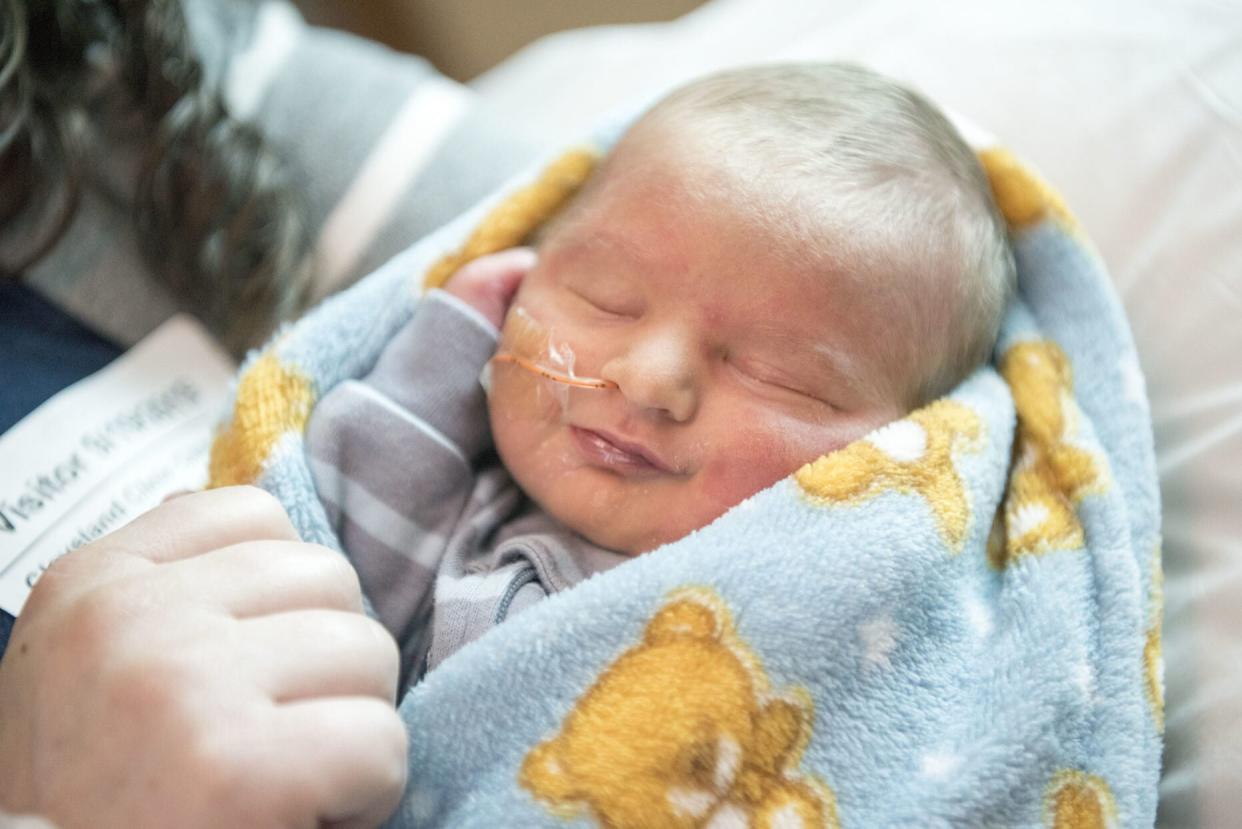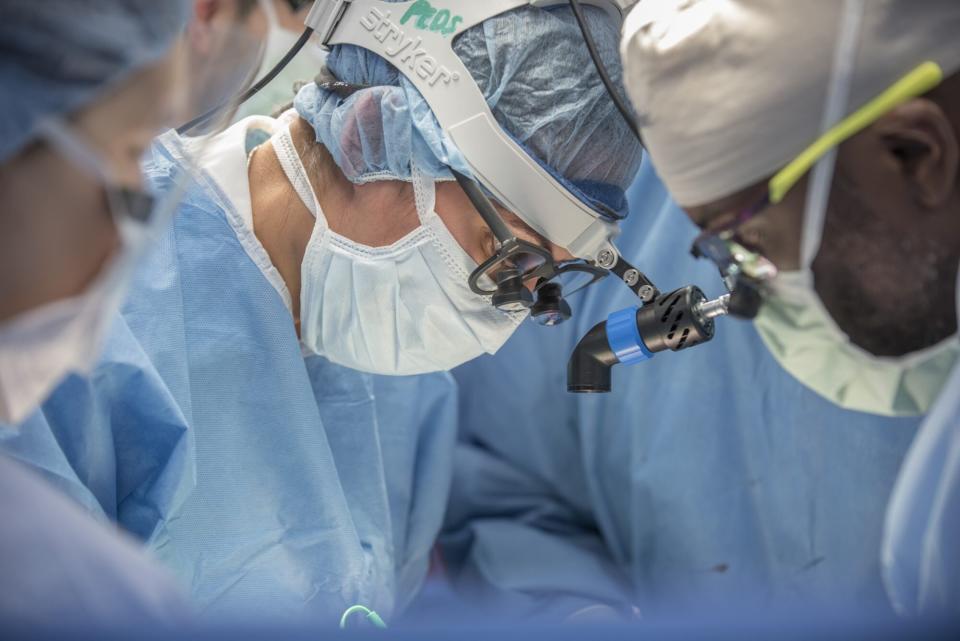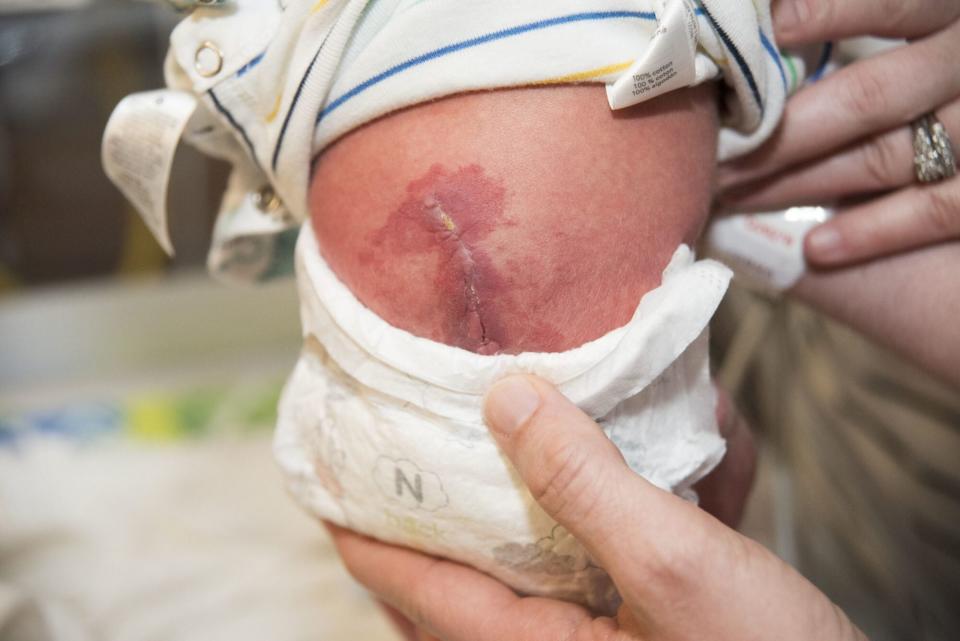Surgeons Repaired This Boy's Spinal Defect Before He Was Even Born

Courtesy Cleveland Clinic
When Kimmie McCaw had bloodwork performed during a routine prenatal appointment, the last thing the 35-year-old mother of three expected was for there to be abnormalities in the results. Kimmie and her husband, Justin, were told by their obstetrician that their unborn son was at risk for spina bifida—a birth abnormality that can lead to physical and intellectual disabilities as a child grows up.
As a precaution, the couple scheduled an appointment with a maternal-fetal medicine specialist, where the spina bifida diagnosis was confirmed via ultrasound. The McCaws were referred to a physician who performed in utero fetal surgeries, but after a day of pokes, prods, and questions, they were declined as patients due to the severe curve in their unborn baby's spine. According to the clinical studies that were performed on similar surgeries, there was no precedent for a correction of this extent and the McCaws were told they would be hard-pressed to find a surgeon who would be willing to perform the repair. But the couple hadn't yet met pediatric surgeon Darrell Cass, M.D., the director of fetal surgery at Cleveland Clinic with 30 years of experience in the field, who was willing to take on the case.
According to Dr. Cass, spina bifida is one of the more common birth abnormalities. "It's one of the more common ones that occur, being about one in 1,500 or so pregnancies each year," he explains. Although research suggests folic acid can help reduce the risk of a fetus developing spinal abnormalities, he says, "We don't usually know exactly what causes it, though sometimes it can be associated with other conditions."
In the McCaws' case, their unborn baby's spinal column didn't close fully, leaving the spinal cord exposed to the fluids in the mother's uterus. If the spinal cord isn't repaired, it can put an unborn child at risk of infection, bowel and bladder dysfunction, damage to the spinal cord and nerves, and even paralysis.
The McCaw's unborn son developed a type of spina bifida called myelomeningocele, where there is an additional concern. Instead of surrounding the brain and then draining back down the spinal column, spinal fluid can leak out of the open area of the spinal column. Similar to water going down a drain, this can pull the back of the brain down with it. The back of the brain (called the cerebellum) can then cause an obstruction to the flow of spinal fluid, which can build up inside the skull and put pressure on the brain, resulting in a condition called hydrocephalus that can impair brain function.
Historically, hydrocephalus has affected 80 to 95 percent of babies born with spina bifida, but according to Dr. Cass, repairing the spinal defect in utero has shown to reduce the emergence of hydrocephalus to around 42 percent of spina bifida cases.
"The really cool and amazing thing is that it's been absolutely proven that if you do this surgery before birth, you improve the child's outcome, and you improve it fairly dramatically," explains Dr. Cass. "You have improved their ability to walk independently—by three years of age you've doubled that baby's ability to walk."

Courtesy Cleveland Clinic
As the McCaws tried to imagine what their new normal would be, they started to prepare for a future that looked dramatically different from what they'd hoped. But soon after the surgical consultation, the couple stumbled across an article describing an in utero spina bifida procedure that had been performed at the Cleveland Clinic—the hospital's first successful spina bifida surgery performed before a baby is born, inside the mother's uterus. Feeling like he had nothing to lose, Justin contacted the clinic and that's when a miracle happened. Two hours after sending their records, Justin received a call from Dr. Cass. After a bit of back and forth, Dr. Cass said something that would change the McCaw's lives forever: "I think it would be a shame for your son not to have this surgery."
The only catch was that the procedure needed to be completed before 26 weeks gestation and at that point, Kimmie was nearing 25 weeks—the McCaws had no time to lose. After a frustrating few days of battling insurance companies, they headed east for Cleveland.
The McCaws arrived in Cleveland and settled into their room at the Ronald McDonald House for what they hoped would be a very long stay. After the surgery, they would need to stay in Cleveland until Kimmie's due date—three months away. Just a day later, Kimmie and their unborn son underwent a 6-hour surgery, during which, Dr. Cass and his team were able to correct the baby's defect.
"What we do is free up the area that's abnormal and allow the spinal cord to flow back inside of the portion of the spinal column that does exist. Then we cover it over with muscle tissue and then some skin," explains Dr. Cass. In other words, while still inside its mother's uterus, the surgeons repaired the structure of the unborn baby's spine and then made sure Kimmie could continue her pregnancy after the operation. And according to Justin, the mom-to-be came out of the operating room with a smile on her face.

In Utero Spina Bifida Surgery Baby Tyler James McCaw in NICU
Two months after the surgery, the McCaws welcomed Tyler James into the world on September 14, 2019. Born at around 34 weeks, he weighed a whopping 5 pounds, 7 ounces, and had no evidence of hydrocephalus at birth. He stayed in the NICU for 12 days and was released to return home to Oklahoma with his family.
Now, almost 6 months later, Tyler is developing normally, strengthening his legs, and has a very good prognosis for a happy and healthy life.
